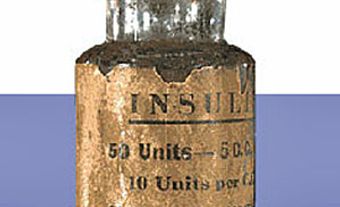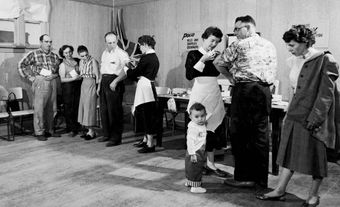During the first half of the 20th century, poliomyelitis, a.k.a. polio or “The Crippler,” hit Canada harder than anywhere else. Successive polio epidemics peaked in a national crisis in 1953. By that time, however, scientists at Connaught Medical Research Laboratories of the University of Toronto had made key discoveries that enabled American medical researcher and virologist Jonas Salk to prepare the first polio vaccine. Connaught Labs also solved the problem of producing the vaccine on a large scale. Canada went on to play an important role in the development of the oral polio vaccine and international efforts to eradicate the disease.
Click here for definitions of key terms used in this article.

What Is Polio?
Poliomyelitis is an infectious disease caused by the poliovirus. The virus only affects humans, and it easily spreads between people, especially young children. It first infects the gut, usually harmlessly, but infection can become serious if the virus invades the nervous system. There, the poliovirus can attack motor neurons in the spinal cord that connect the brain and muscles. It can damage these connections and cause varying degrees of muscle weakness or paralysis. Polio most severely affects the muscles that control breathing.
Polio Epidemics in Canada
Beginning in the late 19th century, polio became a growing epidemic threat. Ironically, this threat increased as public health and sanitary standards improved. Such rising sanitary standards reduced what had been the almost universal and naturally immunizing circulation of the poliovirus among infants. This trend was most apparent in less densely populated communities. Exposure to the virus was thus delayed among increasingly older children, as well as young adults, whose immune systems, when ultimately infected, were less resistant to the virus invading the nervous system and causing paralytic disease. Especially vulnerable were young middle-class families living in new suburbs during the postwar “baby boom.”
Canada experienced its first localized polio outbreaks in the 1910s. The first major wave of larger outbreaks began in the late 1920s. The disease struck several provinces in turn: British Columbia and Alberta (1927), Manitoba (1928), Ontario (1929 and 1930), and then Quebec (1931 and 1932). A second wave of larger epidemics hit Manitoba (1936) and then Ontario (1937), becoming more severe with 2,546 cases and 119 deaths. A third polio wave hit Manitoba and New Brunswick hard in 1941. A fourth, from 1946 to 1953, became the most severe, ultimately reaching every province and even parts of the Arctic. In 1953, there was a total of some 9,000 polio cases and 494 deaths reported across the country.
Did you know?
Many notable Canadians were stricken with polio. Among them were musicians Neil Young and Joni Mitchell. Young got polio in 1951 in Omemee, Ontario, when he was five, and Mitchell got it in 1952 in Saskatoon, Saskatchewan, when she was nine.
Most provincial governments established policies for polio treatment and hospitalization that helped cover the cost of care. Most dramatic and costly were the iron lungs some polio victims needed to breathe. During the 1937 Ontario epidemic, a sharp spike in respiratory paralysis cases prompted the emergency construction of 27 iron lungs in the basement of the Hospital for Sick Children in Toronto. And at the peak of the 1953 epidemic in Manitoba, at least 72 iron lungs operated in one Winnipeg hospital.

Cover of The Horizon, October 1937, showing a nurse with a polio patient in one of the iron lungs manufactured in the basement of the Hospital for Sick Children in Toronto during the major Ontario polio epidemic of 1937.
Early Research toward a Vaccine
The public health, medical and research communities worked very hard to understand why polio seemed to be worsening and how it could be prevented. The media and the broader public also followed these questions closely. Such attention was boosted by the annual fundraising campaigns of the March of Dimes in the United States. These campaigns supported polio treatment and scientific research on a polio vaccine by collecting dimes from door to door. The March of Dimes was inspired by the personal experience with polio of President Franklin D. Roosevelt. It was run by the National Foundation for Infantile Paralysis (NFIP), which Roosevelt helped establish in 1938.
Some of the March of Dimes money flowed north across the border to Connaught Medical Research Laboratories at the University of Toronto. The funds supported a broad poliovirus research program led by Andrew Rhodes, a leading British virologist recruited to Connaught in 1947. Federal Public Health Research Grants and Canadian life insurance companies also supported this work.
Rhodes arrived just as polio research was speeding up. Key advances around this time included the discovery of a way to grow the poliovirus in test tubes. This 1949 breakthrough won a Boston research team the Nobel Prize and opened the door to a polio vaccine.

Canadian Contributions to the Salk Vaccine
Also during the late 1940s, a Connaught team — cell researcher Raymond Parker and biochemists Joseph Morgan and Helen Morton — developed “Medium 199” while studying cancer cell nutrition. It was the world’s first purely synthetic nutrient medium for growing cells. Unlike traditional animal-based serum mixtures used for growing cells, Medium 199 was a chemically pure mixture of 60 ingredients. Its purity made it possible to precisely measure the nutrients cancer cells required. (See also Biological Product.)
In 1951, Morgan suggested to Connaught biochemist Arthur Franklin, who had recently joined the polio research team, that he try using Medium 199 to grow the poliovirus in monkey kidney cells. It worked beautifully, providing a synthetic virus cultivation medium suitable for a human vaccine. This development sped up the work of University of Pittsburgh virologist Jonas Salk. He requested a supply of Medium 199, with which he prepared an inactivated poliovirus vaccine (IPV) that could be safely tested on children.
Vaccine Production and Field Trial
The next major challenge, producing the vaccine on a large scale, was also solved at Connaught. Leone Farrell devised the “Toronto Method” in 1952–53. It involved growing the poliovirus in fluid cultures using large bottles gently rocked on custom-built rocking machines. Based on Salk and Connaught’s progress, the NFIP asked Connaught Labs to provide the poliovirus fluids for a large-scale field trial of the vaccine. The trial would take place across the US, as well as in several parts of Canada and Finland.
This massive experiment involved 1.8 million “polio pioneers,” who were mostly children in Grades 2 and 3. One-third received the vaccine, another third received Medium 199 as a harmless placebo, and the rest were carefully observed. The trial was designed to be triple-blind. This meant that none of the children or researchers involved knew who received the vaccine, the placebo, or neither.
Connaught supplied all 3,000 litres of the poliovirus fluids needed for the trial. It shipped the virus fluids to two pharmaceutical firms in the US for inactivation, processing and final testing in time for vaccinations to begin in April 1954. In the meantime, Connaught prepared the complete vaccine for its carefully monitored Canadian introduction.
Researchers at the Poliomyelitis Vaccine Evaluation Centre at the University of Michigan ran the field trial. They also carried out the complex, unbiased evaluation of the vaccine’s effectiveness. The Centre analyzed the data collected through the work of many thousands of physicians, health workers and others in the 21 study areas of the field trial. In the US, this involved 44 states.
On 12 April 1955, the much-anticipated results of the field trial were finally announced. International headlines exclaimed “It Works!” The vaccine proved to be 60–90 per cent effective against the three antigenic types of poliovirus that circulated in the wild and caused infection. It was immediately licensed for use in the US and Canada.

Nurse with a Toronto Telegram newspaper reporting the 12 April 1955 results of the Salk polio vaccine field trial; the vaccine came too late for the man stricken with polio and using a portable respirator.
Release of the Vaccine
Once the vaccine was licensed, American commercial producers rush-released it with little government control. In Canada, the federal and provincial governments shared the full cost of the vaccine and distributed it free to children. There was a major setback in the US on 25 April, when alarming reports of some polio cases among vaccinated children led to the discovery that certain batches of vaccine produced by Cutter Laboratories in California were not fully inactivated. With 79 polio cases directly linked to the vaccine, the US Surgeon General recalled all of Cutter’s vaccine and set up a national polio surveillance system. On 7 May, the country suspended its entire vaccine program.
North of the border, there was a debate about what Canada should do. Despite some resistance from Prime Minister Louis St-Laurent, health minister Paul Martin Sr. (himself a victim of polio, as was his son, Paul Martin Jr.) decided that vaccinations would continue in Canada. He based his decision on the advice of experts and the fact that there had been no cases of polio linked with Connaught’s vaccine, the only one used in Canada. Canadian use and evaluation of the vaccine further showed that it was safe and effective. This helped pave the way for the US immunizations to resume in July 1955.
The success of the Canadian polio program helped ensure the future worldwide use of the vaccine to control polio. In particular, as Connaught Labs produced more vaccine, it was able to export it to countries that had yet to produce their own. In 1959, Connaught introduced new combined vaccines that added the polio vaccine to diphtheria, pertussis and tetanus vaccines. This further expanded and simplified Canadian polio immunization programs, especially those aimed at adults.
Oral Polio Vaccine
Despite the successful use of IPV, the vaccine’s cost and the need to inject it limited its use in many countries, especially in the developing world. To overcome such limits, scientists developed a second type of polio vaccine that was cheaper to produce and could be more easily given. Beginning in the late 1950s, American researcher Albert Sabin worked to develop a polio vaccine that would build immunity in the gut, where the poliovirus naturally reproduced. His goal was to carefully cultivate weakened poliovirus strains that could be given by mouth with a spoon.
Connaught Labs worked closely with Sabin to produce the oral polio vaccine (OPV) based on Sabin’s weakened strains. After careful testing and a series of unique field demonstrations in several parts of Canada to evaluate the vaccine’s stability, safety and effectiveness, Connaught’s OPV was licensed in 1962. Soon, several provinces, as well the United States, switched from IPV to OPV. Both vaccines worked well, but as a live vaccine, OPV could in very rare cases cause polio if the weakened vaccine strains became virulent. However, in areas where wild polioviruses circulated, health officials were willing to accept the very low risk of using OPV.
By the early 1990s, the World Health Organization’s polio eradication program succeeded in the Americas. Canada, the US and most other countries then switched from OPV back to IPV.
Importance
Connaught Laboratories, today known as Sanofi Pasteur Canada, has played a major role in producing both OPV and IPV. For its part, the Canadian government has been a leader in funding the global polio eradication program. This initiative, inspired by the successful eradication of smallpox in 1979, has reduced global polio incidence from 300,000 cases in 1988 to less than 40 today.

 Share on Facebook
Share on Facebook Share on X
Share on X Share by Email
Share by Email Share on Google Classroom
Share on Google Classroom




